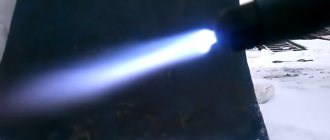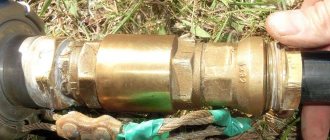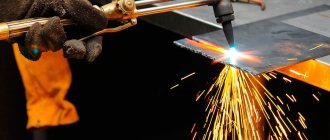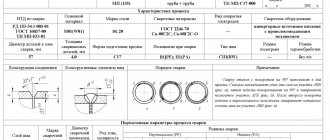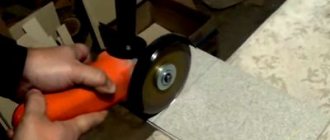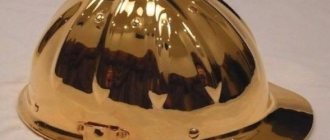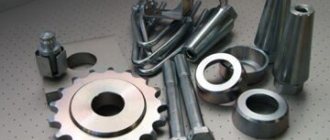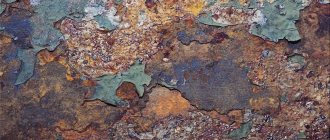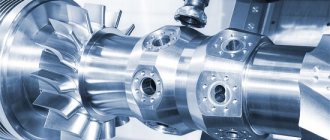When working with an open flame of flammable gas, the worker is at risk of injury due to ignition of the burner or other equipment. A kickback when cutting metal is accompanied by a sharp bang, smoke from the mouthpiece and the cessation (continuation) of combustion. To avoid this phenomenon, it is necessary to check the equipment and, if necessary, reduce the size of the gas supply opening in the burner or reduce the volume of oxygen in the mixture.
Causes of kickback
What leads to such a fatal situation:
• incorrect ignition – incorrect adjustment of oxygen and combustible gas, flame strength; • too much heating of the mouthpiece and the tube onto which it is screwed, which leads to self-ignition of the gas mixture even before it leaves the burner; • debris accumulates in the mouthpiece; if it clogs the hole at its end, the gas pressure at the outlet will increase; • closing the outlet of the mouthpiece by touching the part also interferes with the normal release of gas into the environment. • if the oxygen cylinder runs out or the injector is clogged, etc. – that is, everything that affects oxygen pressure, a sharp change in its value
External signs:
• a sharp bang, but the flame continues to burn (weak flame, incorrect setting); • cotton when combustion stops, smoke comes out of the mouthpiece.
Gas solenoid valve
An electromagnetic gas valve is a device that allows you to control the supply of natural gas automatically. After the valve relay turns on the supply of electricity to the coil, the armature retracts and lifts the plunger, opening the free flow of gas into the working area.
Gas shut-off solenoid valve
After turning off the voltage, the plunger, due to the valve spring, returns to its position and closes the channel between the inlet and outlet fittings, blocking the flow of gas. The main purpose of such a device is the distribution and regulation of gas supply in pipelines, boilers, dispensers and other devices.
You can also read more about the types of control valves.
Purpose of the gas valve
Electromagnetic automatic gas valves are used very widely, both in everyday life and for industrial purposes. This mechanism of the “Lovato” brand, VN series, is most often used in everyday life to control the gas supply to household appliances, such as a gas boiler or water heater. also installed at the gas pipeline inlet to cut off the fuel supply if necessary.
The “Lovato” magnetic assembly of the BH series works like a regular tap, which allows you to shut off the gas flow by pressing a button. Such automatic control devices make the use of natural gas much safer.
In the event of a leak, the solenoid valve can quickly, and most importantly, automatically, shut off the pipeline and prevent the room from filling with a toxic, life-threatening substance.
The gas valve automatically shuts off the gas supply to the pipeline in emergency situations
The magnetic choke “Lovato” of the VN series is used not only for the installation and safety of household gas pipelines. They are used for arranging gas cylinders, as well as during the installation of automobile gas cylinder equipment.
It is also worth noting that there are filters inside the valve that allow you to clean the fuel from additional impurities.
Gas valve device
The electromagnetic gas valve “Lovato” VN series consists of a seat and a shutter. The appearance of the device’s shutter is determined by its appearance. It may resemble a piston or a plate. A valve is a kind of membrane, the function of which is precisely to open or close the gas flow. The gate is mounted on a core connected to an electromagnet and transmits electrical impulses from one device to another.
The magnetic mechanism itself is located outside the valve in its upper part. Receiving an electrical impulse, it creates a magnetic field, which “instructs” the membrane to shut off the gas supply.
Kickback protection - valve
Installing a kickback valve will save your life and protect your equipment from damage and destruction.
It works as follows: the flow of flame penetrating the burner (cutter) or sleeves is immediately extinguished by a fire extinguisher. The counterflow of propane, acetylene or oxygen is stopped by a shut-off spring. The process is blocked by a cermet insert sintered from powder.
There are two types of them:
• for oxygen • and for flammable gas.
They always come in pairs. They are installed on a gearbox or burner (cutter) and withstand at least one hundred reverse flame impulses coming one after another.
Add a comment Cancel reply
You must be logged in to post a comment.
Is it worth BUYING, reviews from welders:
- Welding transformer PATRIOT 200AC 102.00 RUR
- Charger GreenWorks G24C RUB 2,490.00
- Voltage stabilizer PRORAB DVR 1000 2597.22 RUR
- Stabilizer Resanta ASN-2000 N/1-C Lux 3610.00 ₽
- Voltage stabilizer Stavr SN-2000 3920.00 RUR
- Welding machine BauMaster AW-79161 3990.00 RUR
- Hitachi AB17 charger RUB 4,076.87
Hello! The situation when a cutting torch fires is called backfire or countercurrent, and in most cases its occurrence depends on the experience and qualifications of the welder. A propane cutter slams when the gas combustion area moves inside the burner and hoses for various reasons. That is, the rate of combustion of gases turns out to be greater than the rate of their outflow from the cylinders.
Most likely, the propane cutter is firing for one of the following reasons:
- The pressure of propane and oxygen during ignition is incorrectly adjusted.
- The nozzle or torch barrel is overheated. This leads to premature self-ignition of the mixture still inside.
- The flow area of the cutter nozzle has decreased due to mechanical contamination.
- The torch nozzle has touched the workpiece or the cut surface.
- The mixing chamber injector is incorrectly adjusted.
- The oxygen has run out or for some reason its pressure has sharply decreased. For example, the mixing chamber injector is clogged.
A kickback is dangerous due to possible destruction of the cutter, gearboxes, joints, rupture of hoses and explosion. This is a very dangerous situation and must be avoided by all means possible.
If a backflow occurs, you should quickly close the flammable gas valve, then the oxygen valve, and cool the cutter. After cooling, you need to clean the injector, mixing chamber and mouthpieces, tighten everything and check the cutter for leaks.
To avoid kickback, we recommend using DONMET 142 or Donmet 300 cutters. Due to the patented design of the mixing unit, they are highly safe when cutting and resistant to kickback. If you already have a cutter from another manufacturer, we recommend using Donmet check valves OBK and OBG or fire-preventing valves KOK and KOG. They are installed directly on the torch separately for oxygen and fuel gas.
Read also: Do-it-yourself jointer clamp
If you still cannot eliminate these pops, contact our consultants by phone +7.
Gas cutting seems to be a simpler process than gas welding work, and therefore even a person who does not have special skills can cope with it. For this reason, almost any of us can master working with a cutting torch. The main thing here is to understand the essence of gas cutting technology. In modern conditions, propane cutters are increasingly used. Working with them requires the use of both propane and oxygen, since the combination of such substances provides the maximum combustion temperature.
Design and design features of Messer fire protection valves
All safety devices are structurally designed to have several degrees of protection, which are provided by different elements: safety valve, check valve, fire barrier element and flow cutoff. Each of these elements serves as a separate security device, and the elements combined in one product provide comprehensive and multi-level human safety and the safety of expensive equipment.
- Inlet filter. Provide protection against contamination and guarantee long service life and operation of autogenous equipment
- Safety valve. Gas controlled pressure cuts off gas flow if shock waves occur. Gas supply can be restored manually (DS model only)
- Check valve. The check valve allows gases to flow in only one direction and reliably prevents creeping or sudden backflow of air or oxygen into the distribution system or individual cylinder
- Fire retardant element. Stops any flame coming from the gas outlet and reduces the flame temperature to below the flash point so that the gas in the inlet zone cannot ignite
- Flow cutoff. The flow shut-off valve consists of a spring-loaded valve, which is held in place by a fusible link. If the safety device becomes hot due to flash or kickback, the valve is automatically closed by melting the bridge, thereby cutting off the gas flow
All these components are fully implemented in any protective device from Messer.
- Inlet filter. Provide protection against contamination and guarantee long service life and operation of autogenous equipment
- Safety valve. Gas controlled pressure cuts off gas flow if shock waves occur. Gas supply can be restored manually (DS model only)
- Check valve. The check valve allows gases to flow in only one direction and reliably prevents creeping or sudden backflow of air or oxygen into the distribution system or individual cylinder
- Fire retardant element. Stops any flame coming from the gas outlet and reduces the flame temperature to below the flash point so that the gas in the inlet zone cannot ignite
- Flow cutoff. The flow shut-off valve consists of a spring-loaded valve, which is held in place by a fusible link. If the safety device becomes hot due to flash or kickback, the valve is automatically closed by melting the bridge, thereby cutting off the gas flow
Advantages and disadvantages
Cutting metal with propane has a number of advantages , among which are the following:
- Gas cutting is in demand in situations where there is a need to cut metal of considerable thickness or create products according to templates that require the production of a curved cut that cannot be made with a grinder. You also cannot do without a gas cutter even when faced with the task of cutting out a disk from thick metal or making a blind hole of 20-50 mm.
- A gas cutter is a very easy-to-use tool and is lightweight. All home craftsmen who have experience working with gasoline models are aware of the inconveniences associated with large weight, size and noise. In addition to the fact that vibration creates significant inconvenience, the operator is forced to provide serious pressure during operation. Gas models seem to be a more attractive alternative due to the absence of all the above-mentioned disadvantages.
- Using metal cutting with gas allows you to speed up the work by 2 times, which cannot be done using a device equipped with a gasoline engine.
- Among most gases, including gasoline, propane has a lower price. For this reason, it is better suited for carrying out a significant amount of work, for example, if there is a task of cutting steel into scrap metal.
- When using propane cutting, it is possible to create a narrower cut edge than when working with acetylene cutters. At the same time, the method under consideration allows you to create a cleaner cut than what can be done using gasoline torches or a grinder.
Among the disadvantages that propane cutters have, only one should be highlighted: they can be used only for a limited range of types of metals . They are suitable for cutting exclusively low and medium carbon steels, as well as ductile cast iron.
Features of use
Such tools are not suitable for cutting high-carbon steels for the reason that they have a fairly high melting point, which is almost the same as the flame temperature. This leads to the fact that instead of the release of scale, which looks like a column of sparks, from the back side of the sheet, it mixes with the molten metal along the edges of the cut. As a result, oxygen cannot reach the thickness of the metal, which is why it fails to burn through the material.
Difficulties when cutting cast iron are created by the shape of the grains , as well as the graphite between them. True, this does not apply to malleable cast iron. It is impossible to solve the problem if you have to deal with aluminum, copper and their alloys.
It is important to dwell on the following point: the category of low-carbon steels is represented by grades from 08 to 20G, medium-carbon steels - grades from 30 to 50G2. A characteristic feature of carbon steel grades is the presence of the letter U in front of their names.
Tags: torch, welding
Comments 51
In some cases there is no need to drill out anything!, it is adjusted by unscrewing it 1.5-2.5 turns. Unscrew the gas hose, unscrew the injector two turns, open the gas valve and supply oxygen with your finger, plug the gas fitting onto the burners, it sucks air into itself quite strongly, try turning it down half a turn and adding more until you get the strongest air leak. The burner operates by suction of oxygen gas. After this, check for leaks and put it in water.
I unscrewed (adjusted) the injector, nothing helps
